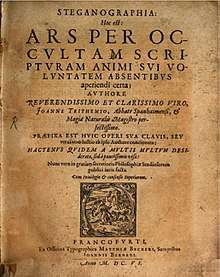Steganographia
Steganographia is a book on steganography, written in c. 1499 by the German Benedictine abbot and polymath Johannes Trithemius.
 Steganographia (1606). | |
| Author | Johannes Trithemius |
|---|---|
| Original title | Steganographia |
| Country | Germany |
| Language | Latin |
| Genre | Cryptographic, steganography |
Publication date | c. 1499 |
Published in English | N/A |
| Media type | Printed book |
| Preceded by | Steganography |
General
Trithemius' most famous work, Steganographia (written c. 1499; published Frankfurt, 1606), was placed on the Index Librorum Prohibitorum in 1609[1] and removed in 1900.[2] This book is in three volumes, and appears to be about magic—specifically, about using spirits to communicate over long distances. However, since the publication of a decryption key to the first two volumes in 1606, they have been known to be actually concerned with cryptography and steganography. Until recently, the third volume was widely still believed to be solely about magic, but the "magical" formulae have now been shown to be covertexts for yet more cryptographic content.[3][4]
Reception
Mentions of the magical work within the third book by such figures as Agrippa and John Dee still lend credence to the idea of a mystic-magical foundation concerning the third volume.[5][6] Additionally, while Trithemius's steganographic methods can be established to be free of the need for angelic–astrological mediation, still left intact is an underlying theological motive for their contrivance. The preface to the Polygraphia equally establishes, the everyday practicability of cryptography was conceived by Trithemius as a "secular consequent of the ability of a soul specially empowered by God to reach, by magical means, from earth to Heaven".[7] Robert Hooke suggested in the chapter Of Dr. Dee's Book of Spirits, that John Dee made use of Trithemian steganography, to conceal his communication with Queen Elizabeth I.[8]
References
- Indice de Libros Prohibidos (1877) [Index of Prohibited Books of Pope Pius IX (1877)] (in Spanish). Vatican. 1880. Retrieved 2 August 2009.
- Index Librorum Prohibitorum (1900) [Index of Prohibited Books of Pope Leo XIII (1900)] (in Latin). Vatican. 1900. p. 298. Retrieved 2 August 2009.
index librorum prohibitorum tricassinus.
- Reeds, Jim (1998). "Solved: The ciphers in book III of Trithemius's Steganographia". Cryptologia. 22 (4): 191–317. doi:10.1080/0161-119891886948.
- Ernst, Thomas (1996). "Schwarzweiße Magie: Der Schlüssel zum dritten Buch der Stenographia des Trithemius". Daphnis: Zeitschrift für Mittlere Deutsche Literatur. 25 (1): 1–205.
- Goodrick-Clarke, Nicholas, The Western Esoteric Traditions: A Historical Introduction (Oxford, New York: Oxford University Press, 2008), pp. 50-55
- Walker, D. P. Spiritual & Demonic Magic from Ficino to Campanella (Pennsylvania: The Pennsylvania State University Press, 2003), pp. 86-90
- Brann, Noel L., "Trithemius, Johannes", in Dictionary of Gnosis & Western Esotericism, ed. Wouter J. Hanegraff (Leiden and Boston: Brill, 2006), pp. 1135-1139.
- Robert Hooke (1705). The Posthumous Works of Robert Hooke. Richard Waller, London. p. 203.
External links
- Steganographia in english (Trithemius.com)